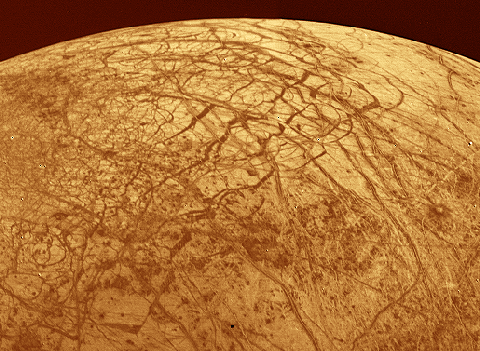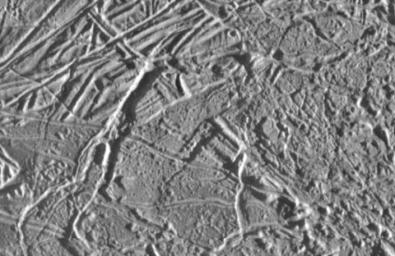Skip to comments.
New JPL mission will provide jobs, discoveries (Mission: study one of Jupiter's moons, Europa)
San Gabriel Valley Tribune ^
| 2/20/09
| Tania Chatila
Posted on 02/20/2009 6:23:34 PM PST by NormsRevenge
LA CANADA FLINTRIDGE - Plans to move forward with an estimated $3-billion project to send a spacecraft to one of Jupiter's moons is ensuring jobs as much as its ensuring discoveries.
Officials at the La Canada Flintridge-based Jet Propulsion Laboratory say a 10-year project resulting in a mission to Europa will offer some stability in a fleeting job market.
"Right now we have another exploration goal," JPL spokeswoman Veronica McGregor said. "We do need future missions for our staff to be able to move on, to do more work. So, obviously having a new mission on our plate is fantastic."
NASA announced plans Wednesday to fund the probe, which would investigate habitable worlds beneath Europa's icy surface.
The mission, expected to launch in 2020, will help maintain JPL's reputation as a healthy NASA center, with 5,000 full-time employees, McGregor said.
"The future workload here at JPL for us is always crucial," she said.
As other JPL missions like the Cassini-Huygens project - which studied Saturn's moon Titan - wind down, officials expect its workforce will switch focus onto the Europa project.
"There was a big workforce that came together to design and plan Cassini and launch it ... you don't want that expertise to go away," Pappalardo said.
The mission to Europa will launch with a second spacecraft being managed by the European Space Agency. That craft will study Jupiter's largest moon, Ganymede, said Robert Pappalardo, a senior research scientist at JPL.
Officials with NASA did not return calls seeking comment Thursday.
"Both (moons) are believed to have internal oceans," Pappalardo said. "We want to understand the nature of these moons, what allows these moons to have oceans are those oceans creating environments that might be favorable for life."
The Europa mission has about 10 years of study behind it, and its importance has often been emphasized in scientific reports because of the oceans that exist so close to the moon's surface, Pappalardo said.
Europa is about the size of Earth's moon and its orbit - the equivalent of three and half Earth days - is egg-shaped.
Once launched, it would take the JPL and European spacecrafts about six years to travel to Jupiter, Pappalardo said. Another two and half years would be spent preparing for orbit around the moons, followed by about nine months to one more year in orbit.
"It sounds like a long time," Pappalardo said. "But I always say, it's about one Jupiter year before we launch and one Jupiter year before it's over."
TOPICS: Astronomy; Science
KEYWORDS: esa; europa; jpl; jupiter; nasa
To: NormsRevenge
Europa is one of the most interesting objects in our solar system.
2
posted on
02/20/2009 6:29:55 PM PST
by
cripplecreek
(The poor bastards have us surrounded.)
To: NormsRevenge
I remember something about being told not to attempt any landings on Europa? ;)
3
posted on
02/20/2009 6:30:37 PM PST
by
1rudeboy
To: 1rudeboy
It's full of stars....
Check your Freepmail, if you get a chance.
4
posted on
02/20/2009 6:41:48 PM PST
by
Toddsterpatriot
(Havoc has been back since September. Or was it April?)
To: 1rudeboy
Dave finally did land on Europa in 3001.
It did not end well.
5
posted on
02/20/2009 7:04:08 PM PST
by
cripplecreek
(The poor bastards have us surrounded.)
To: 1rudeboy
“ALL THESE WORLDS ARE YOURS EXCEPT EUROPA. ATTEMPT NO LANDINGS THERE.”
To: NormsRevenge

From NASA's Astronomy Picture of the Day archives, this Voyager spacecraft image of Europa's surface is suggestive of sea ice on Earth. The criss-crossing dark streaks may indeed be cracks in its ice-covered surface caused by Jupiter's tidal stresses accompanied by the freezing and expansion of an underlying layer of water.


The Galileo Probe's flyby of Europa, Jupiter's ice-covered moon showed a fractured and frozen terrrain. Only a few impact craters are apparent though, implying a geologically young surface. So far, Galileo's findings lend support to the exciting possibility that liquid water once existed and may still exist beneath Europa's surface.
Disclaimer:
Opinions posted on Free Republic are those of the individual
posters and do not necessarily represent the opinion of Free Republic or its
management. All materials posted herein are protected by copyright law and the
exemption for fair use of copyrighted works.
FreeRepublic.com is powered by software copyright 2000-2008 John Robinson


